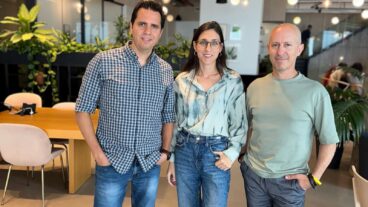Plantware aims to use living trees to create a variety of useful structures like this playground for children.
America’s Axel Erlandson envisioned sustainable urban design in the 1920s and by the 1940s had opened his very own Tree Circus. The idea was to coax young trees to grow into shapes that could be useful – as benches, awnings or even small shelters.
A group of young Israeli idealists have taken Erlandson’s vision to another level. Inspired by fig trees growing on structures in Africa, Plantware’s founders have found a way to manipulate roots from trees such as figs, and to grow them into useful structures.
The aim is to one day build the structures of homes from living trees – and save the planet at the same time.
Plantware’s CEO Gorden Glazer sees the first home prototype ready in about 10 years. Currently the company has taken its patented methods and built park benches, playgrounds, streetlamps and gates – all from trees.
“We are not artists looking for fame,” says Glazer, who is motivated mainly by environmental concerns. He tells ISRAEL21c: “We want to create a message that’s accessible to as many people as possible.”
And what’s the message? When one buys a Plantware product, the consumer not only purchases a useful object, but a small opportunity to save the planet. Since trees sequester greenhouse gases, and Plantware products eliminate the use of raw materials, the result is a solution that is in perfect harmony with Mother Nature.
The idea to develop Plantware into a company happened in a plant research lab at Tel Aviv University, where Glaze was studying plant genetics. There he met Yaniv Naftali from the eco-village Klil in the Western Galilee, who was also studying plants.
There, at the world’s largest aeroponic root research lab (plants are grown in air instead of water or in soil) in the world, Glaze and Naftali noticed something interesting about plant roots.
“Typically in that lab, at the end of an experiment plants are thrown away,” says Glaze. “I said what if we don’t throw them away but put them on a template, will they survive?” Glaze and Naftali discovered that certain species of plants, which were grown by aeroponic methods, were not lignifying (hardening).
They understood that they had found a way for growing soft roots, roots that could be eventually manipulated into becoming specific structures.
Today with a patent on the process, Plantware, in operation since 2002, is the first company in the world to take on the challenge of designing furniture, park benches, bus stops and even city dwellings from living trees.
Based in Jerusalem, the company recently received a $250,000 investment to build prototypes in Australia, the US and in Israel. Advanced breeding and horticultural techniques combined with modern aesthetics has allowed them to “produce elegant products that are also eco-positive,” says the company.
In some circles, the company’s approach may be known as tree shaping, arborsculpture, living art or pooktre.
While not every person dreams of living like the Swiss Family Robinson, Plantware’s Glaze says the company anyway isn’t out to create treehouses, which are typically made from non-living material.
So far the company has given a living Plantware bench to a children’s hospital in Israel, and is now donating a seven-foot tree shaped as a Star of David to President Shimon Peres in honor of Israel’s 60 years of independence.
Will Plantware one day create entire cities out of trees? “Our aspirations aren’t quite that lofty,” says Glaze. “We’d like to show that it’s possible.”
He doesn’t have any scientific evidence if a futuristic Plantware home will be better at withstanding earthquakes, but does note that tree growth is a slow process, and that the frame of a house, built from roots, shouldn’t move any more than a typical non-living house does today.
The idea resonates with the public: “This sounds [like] an amazing idea,” writes UK-based author Steve N. Lee, author of an eco thriller, What if? “I love the idea of a ‘fantasyland’ theme to make the mundane special.
“By using trees as building components, not only would it bring people closer to nature, and thereby encourage appreciation of it, but it would provide more natural habit for wildlife in our towns and cities.”













